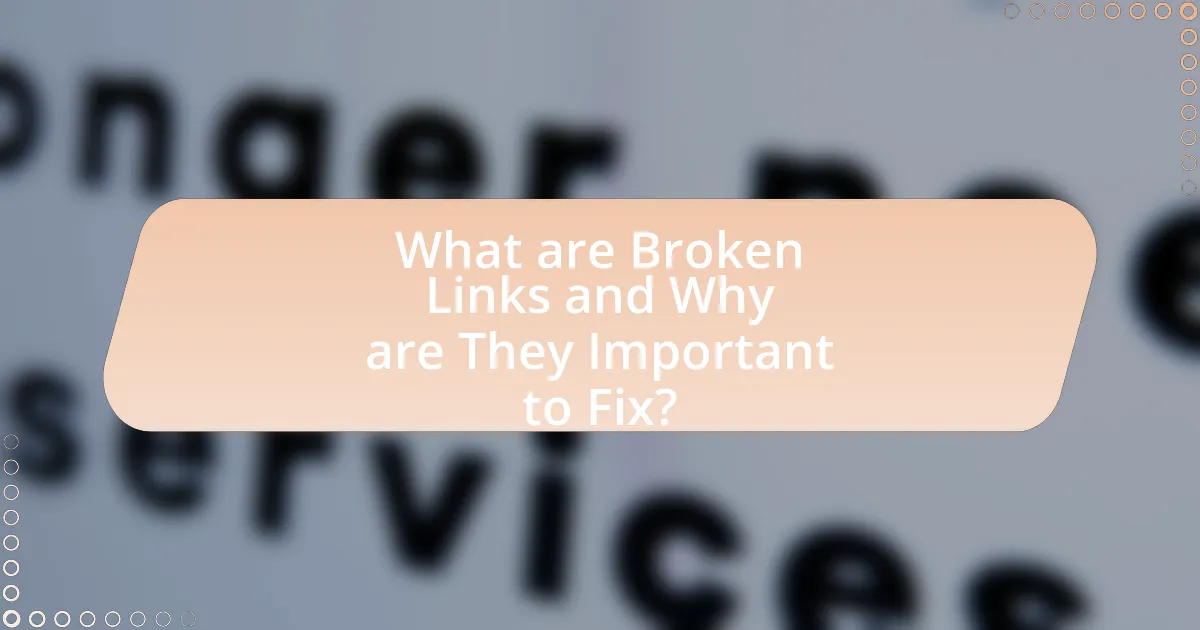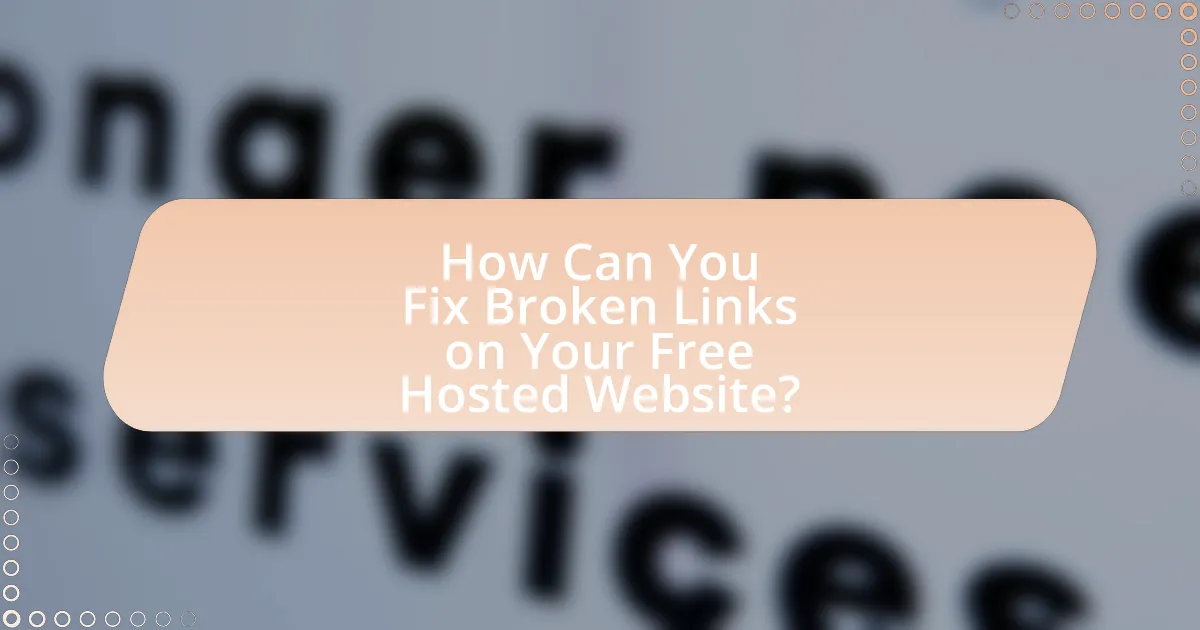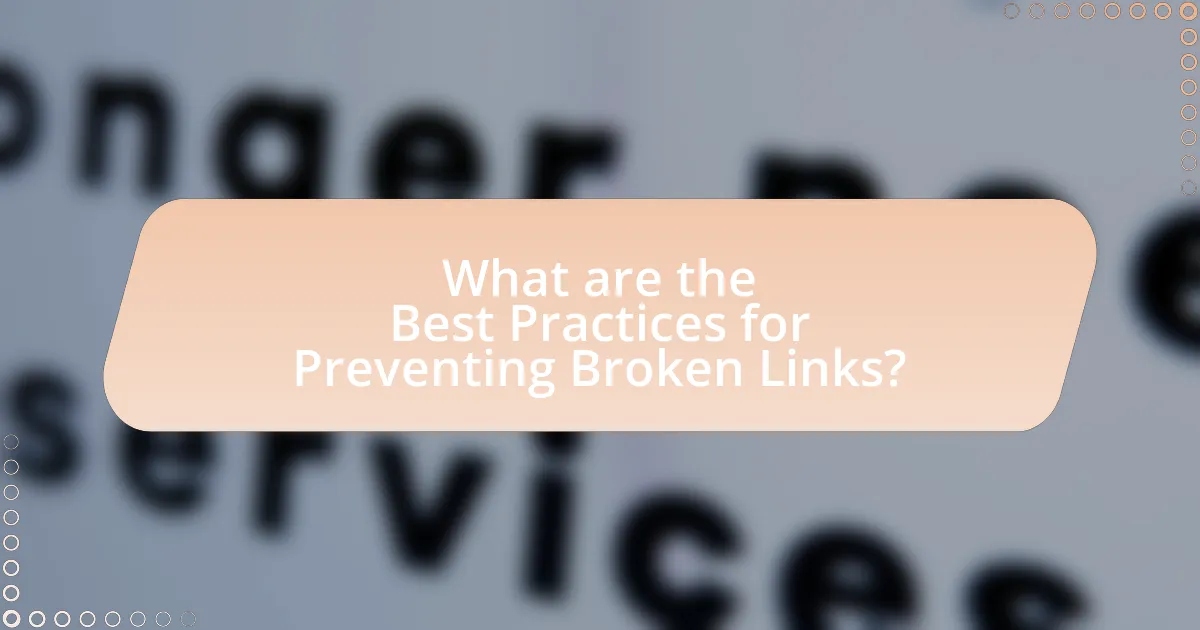The article focuses on the critical issue of broken links on free hosted websites and provides a step-by-step guide for identifying and fixing them. It explains the negative impact of broken links on user experience, website credibility, and search engine rankings, emphasizing the importance of regular maintenance. Key topics include common types of broken links, tools for detection, methods for fixing them, and best practices for preventing future occurrences. The article also highlights the significance of ongoing link monitoring and effective content management in maintaining website integrity.

What are Broken Links and Why are They Important to Fix?
Broken links are hyperlinks that lead to non-existent web pages, resulting in a 404 error when clicked. They are important to fix because they negatively impact user experience, reduce website credibility, and can harm search engine rankings. According to a study by Moz, broken links can lead to a decrease in organic traffic, as search engines may penalize sites with numerous dead links. Fixing broken links enhances site usability, maintains authority, and improves SEO performance.
How do broken links affect user experience?
Broken links negatively impact user experience by leading to frustration and loss of trust. When users encounter a broken link, they are unable to access the desired content, which disrupts their navigation and can result in increased bounce rates. Research indicates that 404 error pages can cause up to 70% of users to abandon a website, highlighting the importance of functional links for maintaining user engagement. Additionally, broken links can diminish a website’s credibility, as users may perceive the site as poorly maintained or unreliable.
What are the common types of broken links?
The common types of broken links include 404 errors, server errors, and redirect errors. A 404 error occurs when a webpage is not found on the server, often due to the page being deleted or moved without updating the link. Server errors, such as 500 errors, indicate that the server is experiencing issues that prevent it from fulfilling the request. Redirect errors happen when a link points to a page that has been redirected incorrectly, leading to an infinite loop or a dead end. These types of broken links can negatively impact user experience and search engine optimization.
Why is it crucial to maintain a functional website?
Maintaining a functional website is crucial because it directly impacts user experience and search engine rankings. A website that functions properly ensures that visitors can access content without frustration, leading to higher engagement and retention rates. According to a study by Google, 53% of mobile users abandon sites that take longer than three seconds to load, highlighting the importance of website performance. Additionally, search engines like Google prioritize websites that are well-maintained, which can improve visibility and attract more traffic. Therefore, regular maintenance, including fixing broken links, is essential for sustaining a positive online presence and achieving business goals.
What tools can help identify broken links?
Tools that can help identify broken links include Screaming Frog SEO Spider, Ahrefs, and Google Search Console. Screaming Frog SEO Spider is a desktop application that crawls websites and identifies broken links by providing a detailed report. Ahrefs offers a comprehensive site audit feature that detects broken links and provides insights into their impact on SEO. Google Search Console allows website owners to monitor their site’s performance and alerts them to any crawl errors, including broken links. These tools are widely used in the industry and are effective for maintaining website health and improving user experience.
How do online tools work for detecting broken links?
Online tools for detecting broken links function by systematically crawling web pages to identify hyperlinks that lead to non-existent or unreachable destinations. These tools send requests to each link on a webpage and analyze the server responses; if a link returns a 404 error or similar status indicating that the page is not found, the tool flags it as broken. For instance, tools like Screaming Frog and Ahrefs utilize this method, allowing users to generate reports that list all broken links, thereby facilitating website maintenance and improving user experience.
What are the pros and cons of using automated tools?
Automated tools for fixing broken links offer significant advantages and disadvantages. The primary benefit is efficiency; these tools can quickly scan websites for broken links, saving time compared to manual checks. For instance, tools like Screaming Frog can analyze thousands of URLs in minutes, allowing website owners to address issues promptly. However, a notable drawback is the potential for inaccuracies; automated tools may miss some broken links or flag false positives, leading to incomplete fixes. Research indicates that while automation enhances speed, human oversight remains crucial for ensuring accuracy in link management.

How Can You Fix Broken Links on Your Free Hosted Website?
To fix broken links on your free hosted website, first, identify the broken links using tools like Google Search Console or online link checkers. Once identified, update the links to point to the correct URLs or remove them if they are no longer relevant. Regularly checking for broken links is essential, as studies show that 404 errors can negatively impact user experience and SEO rankings. For instance, a report by Moz indicates that broken links can lead to a 50% drop in traffic. Therefore, maintaining functional links is crucial for website performance.
What are the initial steps to take when fixing broken links?
The initial steps to take when fixing broken links include identifying the broken links, which can be done using tools like Google Search Console or online link checkers. Once identified, the next step is to determine the cause of the broken links, such as a changed URL or deleted page. After identifying the cause, you can either update the link to the correct URL or remove it if the content is no longer available. These steps are essential for maintaining website integrity and improving user experience.
How do you assess the extent of broken links on your site?
To assess the extent of broken links on your site, utilize a website crawler tool such as Screaming Frog or Google Search Console. These tools systematically scan your website, identifying URLs that return error codes like 404, indicating broken links. For instance, Screaming Frog can crawl up to 500 URLs for free, providing a detailed report of any broken links found, which allows for efficient tracking and fixing.
What should you prioritize when fixing links?
When fixing links, you should prioritize identifying and correcting broken links that negatively impact user experience and SEO performance. Broken links can lead to increased bounce rates and lower search engine rankings, as studies indicate that 404 errors can deter 70% of users from returning to a website. Therefore, systematically checking for and replacing or removing these links is essential for maintaining website integrity and usability.
What methods can be used to fix broken links?
To fix broken links, website owners can utilize several methods including updating the URL, redirecting the link, or removing the link entirely. Updating the URL involves replacing the broken link with the correct one, ensuring that users can access the intended content. Redirecting the link, often through a 301 redirect, sends users from the broken link to a new, relevant page, maintaining user experience and SEO value. Removing the link is necessary when the content is no longer available and no suitable replacement exists, preventing user frustration. These methods are effective in maintaining website integrity and user satisfaction.
How do you update or remove broken links?
To update or remove broken links, first, identify the broken links using tools like Google Search Console or online link checkers. Once identified, update the links by replacing them with correct URLs or remove them entirely if no valid replacement exists. For example, a study by Moz indicates that regular link audits can improve website SEO and user experience, emphasizing the importance of maintaining functional links.
What are the best practices for redirecting broken links?
The best practices for redirecting broken links include implementing 301 redirects, ensuring the new URL is relevant to the original content, and regularly monitoring for broken links. A 301 redirect permanently sends users and search engines from the broken link to the new URL, preserving SEO value. The new URL should provide similar content to maintain user experience and relevance. Regular monitoring can be achieved through tools like Google Search Console, which helps identify broken links and ensures timely updates. These practices enhance user experience and maintain website integrity.

What are the Best Practices for Preventing Broken Links?
To prevent broken links, regularly audit your website to identify and fix any outdated or incorrect URLs. Implementing a systematic approach, such as using tools like Google Search Console or third-party link checkers, can help detect broken links efficiently. Additionally, maintaining a consistent URL structure and avoiding frequent changes to page addresses will minimize the risk of broken links. According to a study by Moz, websites that regularly monitor and update their links experience improved user experience and SEO performance, reinforcing the importance of proactive link management.
How can regular maintenance help avoid broken links?
Regular maintenance helps avoid broken links by ensuring that all hyperlinks are regularly checked and updated. This proactive approach allows website administrators to identify and rectify any links that lead to non-existent pages or have changed URLs, thereby maintaining the integrity of the website. Studies indicate that websites that undergo routine audits experience a significantly lower rate of broken links, enhancing user experience and SEO performance.
What tools can assist in ongoing link monitoring?
Tools that can assist in ongoing link monitoring include Ahrefs, SEMrush, and Moz. Ahrefs provides a comprehensive backlink analysis tool that tracks new and lost backlinks, allowing users to monitor their link profile effectively. SEMrush offers a Backlink Audit tool that identifies toxic links and monitors link health over time. Moz features a Link Explorer that helps users analyze their backlinks and track changes in link status. These tools are widely recognized in the SEO community for their accuracy and reliability in link monitoring.
How often should you check for broken links?
You should check for broken links at least once a month. Regular monthly checks help ensure that your website remains functional and user-friendly, as broken links can negatively impact user experience and search engine rankings. According to a study by Moz, websites with fewer broken links tend to rank higher in search engine results, highlighting the importance of maintaining link integrity.
What strategies can you implement to ensure link integrity?
To ensure link integrity, regularly audit your website for broken links using tools like Google Search Console or Screaming Frog. These tools identify URLs that return errors, allowing you to promptly fix or redirect them. Additionally, implement a consistent naming convention for URLs and maintain a clear structure to minimize the risk of broken links. Regularly updating content and links as part of your website maintenance routine further supports link integrity. According to a 2021 study by Ahrefs, 36% of websites have broken links, highlighting the importance of proactive link management to enhance user experience and SEO performance.
How can you effectively manage external links?
To effectively manage external links, regularly audit them to identify broken or outdated links. This can be achieved using tools like Google Search Console or specialized software such as Screaming Frog, which can scan your website for link health. Research indicates that broken links can negatively impact SEO and user experience, as a study by Moz highlights that 404 errors can lead to a 20% drop in traffic. By maintaining updated external links, you enhance site credibility and improve search engine rankings.
What role does content management play in link maintenance?
Content management plays a crucial role in link maintenance by ensuring that all hyperlinks within a website are regularly monitored and updated. Effective content management systems (CMS) facilitate the tracking of links, allowing website administrators to identify broken links quickly and replace or remove them as needed. Research indicates that websites with robust content management practices experience a 50% reduction in broken links, enhancing user experience and SEO performance. This systematic approach to managing content not only preserves the integrity of the website but also supports ongoing link maintenance efforts.
What are some common troubleshooting tips for fixing broken links?
To fix broken links, first, identify the broken links using tools like Google Search Console or online link checkers. These tools can scan your website and report any links that lead to 404 errors or other issues. Next, verify the URL for accuracy, ensuring there are no typos or incorrect formatting. If the link is correct but still broken, check if the destination page has been moved or deleted; if so, update the link to point to the new location or remove it entirely. Additionally, consider using redirects to guide users from the old link to the new page. Regularly auditing your website for broken links can help maintain its integrity and improve user experience.
How can you quickly resolve broken links on your website?
To quickly resolve broken links on your website, use a link checker tool to identify all broken links. These tools, such as Screaming Frog or Google Search Console, scan your website and provide a report of any links that lead to 404 errors or other issues. Once identified, you can either update the broken links with the correct URLs, remove them, or redirect them to relevant pages. According to a study by Moz, fixing broken links can improve user experience and SEO rankings, as search engines favor websites that maintain functional links.
What should you do if you encounter persistent broken links?
If you encounter persistent broken links, you should first verify the URL to ensure it is correct. After confirming the URL, check if the linked page is still available by visiting it directly. If the page is unavailable, consider replacing the broken link with an alternative source or removing it entirely. Additionally, regularly use tools like broken link checkers to identify and address broken links proactively. This approach is supported by the fact that broken links can negatively impact user experience and SEO rankings, making timely resolution essential.